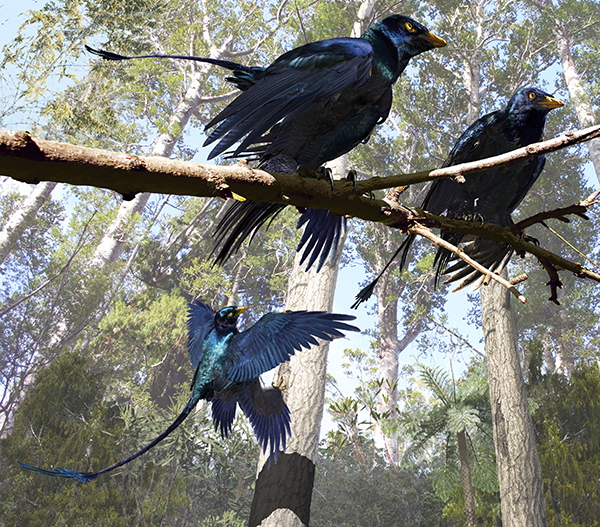
by Mary Caperton Morton Thursday, March 8, 2012

Artist's conception of a _Microraptor_, which has been discovered to have sported iridescent plumage. Courtesy of Jason Brougham, University of Texas
Our knowledge of the evolution of feathers in dinosaurs is sketchy, at best, but new research on fossilized feathers is painting a remarkably clear picture of what one species, known as Microraptor, may have looked like — a raven with black iridescent feathers. The findings may have implications for the importance of sexual display in the early origins of feathers.
“For a long time, we wondered whether dinosaurs were birds and whether they had feathers,” says Richard Prum, an ornithologist at Yale University who was not involved in the new study. But over the past few years, it has become “quite clear that feathers originated in dinosaurs, well before the origin of birds and well before the origin of flight,” he says.
Fossilized feathers are rare, but the discovery of a collection of well-preserved fossils in Liaoning, China, in the early 1990s, has provided a wealth of information about the transition from feathered dinosaurs to birds.
Dinosaur feathers likely arose as proto-feather microfilament fibers for insulation, but several specimens have been found with feathers that are almost indistinguishable from modern bird feathers, Prum says. “Dinosaur feathers are feathers in every sense,” he says. “There are species differences, like there are between crow feathers and pigeon feathers, but there’s no distinction between bird feathers and dinosaur feathers.”
The close morphology between bird and dinosaur feathers is what led researchers to a breakthrough in studying plumage — colors, patterns and arrangements of feathers — in fossils. Modern and fossil bird feathers have microscopic pigment packages called melanosomes that determine the color and sheen of a bird’s plumage.
“As it turns out, the shape of the melanosomes correlates very well with the color they produce,” says Julia Clarke, a paleontologist at the University of Texas at Austin and an author of the new study, published today in Science.
Looking at samples of fossilized Microraptor feathers under a scanning electron microscope, Clarke and colleagues saw long, sausage-shaped melanosomes, which correlate with black coloration in modern birds. Random samples taken from all over Microraptor indicate the dinosaur was a solid color, unlike other previously studied feathered dinosaur species, which showed distinct striping.
Then, the team made yet another new discovery: The sheet-like layered packaging of the melanosomes of Microraptor was identical to modern birds with iridescent feathers. “This is the earliest evidence for iridescence in feathered dinosaurs,” Clarke says. Previously, the oldest fossil in which iridescence had been observed was a 40-million-year-old fossilized bird feather, whereas Microraptor is 120 million years old.
Iridescent plumage wasn’t the only showy thing about Microraptor. Previous descriptions of multiple fossil specimens also note long, ornamental tail feathers. “In living birds, iridescence is often related to sexual selection,” Clarke says. The fact that Microraptor boasted at least two ornaments — the iridescence and the long tail feathers — is a strong indication that sexual selection was a key player in the early evolution of feathers, she says.
Furthermore, she adds, fossil evidence for long tail feathers, flashy spangles and striped tails has been found in feathered dinosaurs as well as in fully evolved birds, “so, it’s possible that the tail has had a display function throughout the whole transition from dinosaurs to birds.”
Microraptor’s feathers were nearly identical to modern birds, but whether it was capable of flight is still unknown. Flight takes more than feathers, Clarke says. “A complex locomotive behavior like flight has to be assembled.” Flight at the Microraptor-stage of the dinosaur family tree — if it occurred — is unlikely to have resembled modern bird flight, which has been perfected over millions of years. “Microraptor shows us part of the process of tinkering and adapting to move in new ways.”
Now that the techniques for studying dinosaur plumage are better understood, Clarke says she expects to see more studies being done on the assemblage from China. “We’re going to see a lot of advances in this area in the next few years. There are a relatively large number of candidate fossils for this kind of study.”
Even if a picture of flight at this stage remains elusive, knowing what Microraptor and other feathered dinosaurs looked like is a huge step, Prum says. “The fact that they look like birds we have around today is fascinating. However, it’s not unexpected. This is what you’d expect a plumage to look like,” he says.
“What’s unexpected is that we can to do this science at all,” he says. “As shocking as it is, a field guide to dinosaurs is becoming a real possibility.”
© 2008-2021. All rights reserved. Any copying, redistribution or retransmission of any of the contents of this service without the expressed written permission of the American Geosciences Institute is expressly prohibited. Click here for all copyright requests.